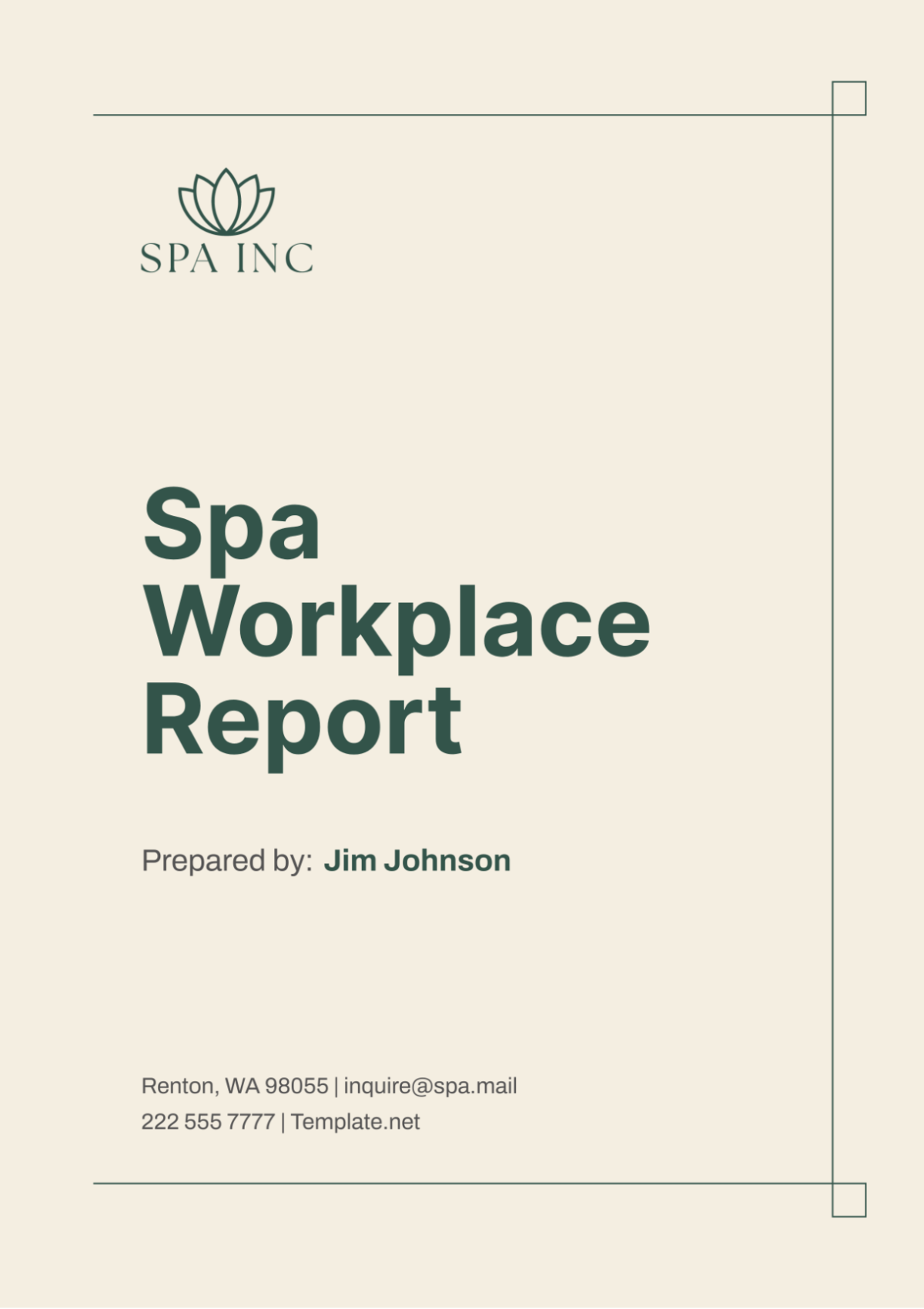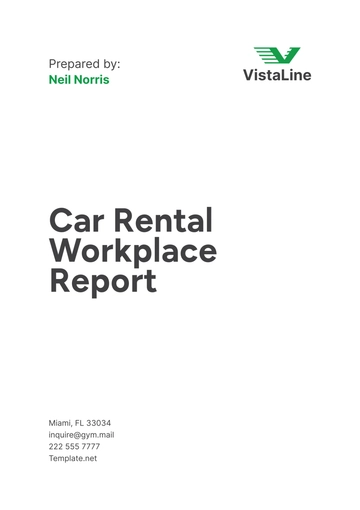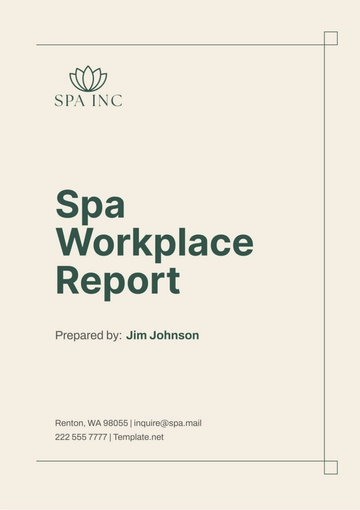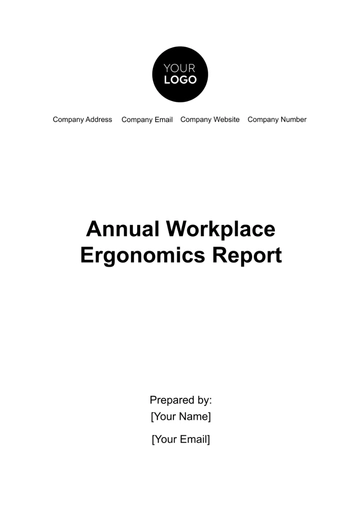Free Spa Workplace Report

I. Introduction
A. Purpose of the Report
The primary purpose of this report is to provide a comprehensive analysis of the current state of the workplace environment at [Your Company Name] Spa. This includes an in-depth review of the facilities, staffing, customer service, health and safety standards, and financial performance. The report aims to identify strengths and areas for improvement, offering actionable recommendations to enhance the overall operation and customer satisfaction.
B. Scope and Objectives
The scope of this report encompasses all aspects of the spa's operations, from facility maintenance to customer interactions. The objectives are to:
Assess the condition and maintenance of spa facilities.
Analyze the roles, responsibilities, and scheduling of staff.
Evaluate customer feedback and service quality.
Review health and safety protocols.
Examine financial performance, including revenue and expenses.
Recommend improvements for marketing and promotional strategies.
C. Methodology
The data for this report was collected through various means, including customer surveys, staff interviews, financial records, and direct observations. Customer feedback was gathered through online and in-person surveys, while staff input was obtained through structured interviews and anonymous feedback forms. Financial performance data was analyzed using monthly and annual financial statements. Observations were conducted to assess the physical condition of the facilities and the implementation of health and safety protocols.
II. Spa Facility Overview
A. Description of Spa Facilities
[Your Company Name] Spa boasts a wide array of facilities designed to offer a relaxing and rejuvenating experience to its clients. The main areas include treatment rooms, relaxation areas, sauna and steam rooms, and reception and waiting areas.
Treatment Rooms
The spa features ten treatment rooms, each equipped with state-of-the-art facilities to provide a range of services, including massages, facials, and body treatments. Each room is designed to create a tranquil environment, with soothing music, adjustable lighting, and comfortable treatment beds. The rooms are also equipped with essential oils, hot stones, and other necessary equipment for specialized treatments.
Relaxation Areas
The relaxation areas are designed to offer clients a serene space to unwind before and after their treatments. These areas are furnished with comfortable seating, soft lighting, and a selection of refreshments, including herbal teas and infused water. The ambiance is enhanced by the gentle sound of water features and calming background music.
Sauna and Steam Rooms
The spa includes two saunas and two steam rooms, providing clients with the benefits of heat therapy. The saunas are equipped with infrared technology, offering a more intense and therapeutic heat experience. The steam rooms are designed with aromatic steam infusions, enhancing the relaxation and detoxification process.
Reception and Waiting Areas
The reception and waiting areas are the first points of contact for clients. These areas are designed to be welcoming and comfortable, with a modern and stylish decor. The reception desk is staffed by friendly and professional personnel who manage bookings, payments, and customer inquiries. The waiting area is equipped with comfortable seating, reading materials, and a display of spa products available for purchase.
B. Facility Maintenance and Upkeep
Maintaining the high standards of [Your Company Name] Spa's facilities is crucial to ensuring a positive customer experience. Regular maintenance schedules and strict upkeep protocols are in place to preserve the quality and cleanliness of the spa environment.
Cleaning Schedules
A detailed cleaning schedule is followed to ensure that all areas of the spa are kept spotless. Treatment rooms are cleaned and sanitized after each use, with a more thorough cleaning performed at the end of each day. Relaxation areas, saunas, and steam rooms are cleaned multiple times throughout the day. The reception and waiting areas are tidied and disinfected regularly to maintain a hygienic environment.
Area | Cleaning Frequency | Responsible Staff |
|---|---|---|
Treatment Rooms | After each use, nightly | Therapists, Cleaners |
Relaxation Areas | Every 3 hours | Cleaners |
Saunas and Steam Rooms | Every 4 hours | Cleaners |
Reception Areas | Every 2 hours | Front Desk Staff |
Equipment Maintenance
Regular maintenance checks are conducted on all equipment to ensure they are in optimal working condition. This includes treatment beds, saunas, steam rooms, and other specialized equipment. Any issues identified during these checks are addressed immediately to prevent service interruptions.
Facility Upgrades
To keep up with industry standards and enhance the client experience, the spa undergoes periodic upgrades. This includes updating decor, replacing worn-out furniture, and investing in new treatment technologies. Recent upgrades have included the installation of new infrared saunas and the refurbishment of the relaxation areas.
III. Staff and Workforce Analysis
A. Staff Roles and Responsibilities
The success of [Your Company Name] Spa is largely attributed to its dedicated and professional staff. Each member plays a crucial role in ensuring that clients receive exceptional service.
Therapists and Technicians
Therapists and technicians are responsible for delivering the various treatments offered by the spa. This includes massages, facials, body wraps, and other specialized services. They are highly trained professionals with certifications in their respective fields. Their responsibilities include preparing treatment rooms, conducting treatments according to established protocols, and providing aftercare advice to clients.
Reception and Front Desk Staff
The reception and front desk staff are the first point of contact for clients. They manage bookings, handle payments, and respond to customer inquiries. They play a crucial role in setting the tone for the client experience, ensuring that each interaction is friendly, professional, and efficient.
Management and Supervisors
The management team is responsible for overseeing the daily operations of the spa. This includes managing staff schedules, ensuring compliance with health and safety regulations, handling customer complaints, and implementing strategic initiatives to enhance service quality and profitability. Supervisors assist with these tasks and ensure that staff adhere to the spa's high standards.
B. Staffing Levels and Scheduling
Effective staffing levels and scheduling are vital to ensuring smooth operations and high-quality service delivery at [Your Company Name] Spa.
Employee Roster
The spa employs a diverse team of professionals, including therapists, receptionists, cleaners, and management staff. The current roster includes 20 therapists, 5 receptionists, 4 cleaners, and 3 management personnel.
Shift Schedules
Staff schedules are meticulously planned to ensure adequate coverage during peak and off-peak hours. Therapists and receptionists work in shifts to provide continuous service throughout the day. The shift schedule is designed to balance workload and prevent staff burnout.
Position | Morning Shift | Afternoon Shift | Evening Shift |
|---|---|---|---|
Therapists | 8:00 AM - 2:00 PM | 2:00 PM - 8:00 PM | 4:00 PM - 10:00 PM |
Receptionists | 7:00 AM - 1:00 PM | 1:00 PM - 7:00 PM | 3:00 PM - 9:00 PM |
Cleaners | 6:00 AM - 12:00 PM | 12:00 PM - 6:00 PM | 6:00 PM - 12:00 AM |
Staffing Adequacy
Regular assessments are conducted to ensure that staffing levels are adequate to meet the demands of the spa's operations. This includes monitoring customer bookings and feedback to identify periods of high demand and adjusting schedules accordingly. The goal is to ensure that clients receive timely and efficient service without compromising on quality.
IV. Customer Service and Experience
A. Customer Feedback and Satisfaction
Customer feedback is a crucial component of the continuous improvement process at [Your Company Name] Spa. Various methods are employed to gather and analyze customer feedback to gauge satisfaction and identify areas for improvement.
Survey Results
Customer surveys are conducted regularly to collect feedback on various aspects of the spa experience, including service quality, staff professionalism, facility cleanliness, and overall satisfaction. The surveys are designed to be comprehensive yet easy for customers to complete.
Recent survey results indicate high levels of customer satisfaction, with 85% of respondents rating their overall experience as excellent. Specific areas of praise include the professionalism of the therapists, the cleanliness of the facilities, and the relaxing ambiance of the spa.
Customer Complaints and Resolutions
While the majority of feedback is positive, any customer complaints are taken seriously and addressed promptly. A structured process is in place for handling complaints, which includes acknowledging the issue, investigating the cause, and implementing corrective actions. Common complaints typically involve booking issues or specific treatment concerns, and each is resolved to the customer's satisfaction to maintain trust and loyalty.
B. Service Quality
Ensuring high service quality is a top priority for [Your Company Name] Spa. This involves maintaining consistent standards across all treatments and customer interactions.
Treatment Effectiveness
The effectiveness of treatments is regularly evaluated through customer feedback and internal quality assessments. Therapists are trained to follow standardized protocols for each treatment, ensuring consistency and effectiveness. Additionally, ongoing training and professional development opportunities are provided to keep staff updated on the latest techniques and best practices.
Customer Interaction
Positive customer interaction is key to a memorable spa experience. Staff are trained in customer service best practices, including effective communication, active listening, and empathy. The goal is to make each client feel valued and cared for, from the moment they arrive until they leave the spa.
C. Loyalty Programs and Memberships
[Your Company Name] Spa offers various loyalty programs and memberships to reward repeat customers and encourage long-term relationships.
Membership Benefits
Membership programs provide clients with a range of benefits, including discounted services, priority booking, and exclusive access to special events. These programs are designed to offer value and convenience, encouraging customers to visit the spa more frequently.
Customer Retention Strategies
In addition to membership programs, various customer retention strategies are employed. This includes personalized follow-ups, special promotions for loyal customers, and occasional complimentary services. These efforts help to build strong relationships with clients, enhancing their loyalty and satisfaction.
V. Health and Safety Standards
A. Hygiene Protocols
Maintaining high hygiene standards is essential for ensuring the safety and well-being of both clients and staff at [Your Company Name] Spa.
Sanitation Practices
Strict sanitation practices are followed to prevent the spread of infections and ensure a clean environment. This includes regular disinfection of treatment rooms, equipment, and common areas. Disposable items, such as linens and towels, are used wherever possible and are replaced after each use. Additionally, hand sanitizers are available throughout the spa for both staff and client use.
Personal Protective Equipment (PPE)
Staff are required to wear appropriate personal protective equipment (PPE) during treatments, including gloves, masks, and aprons. This is especially important for treatments that involve close contact with clients. PPE is also provided to clients as needed, ensuring mutual protection.
B. Safety Procedures
In addition to hygiene protocols, various safety procedures are implemented to safeguard the health and well-being of everyone at the spa.
Emergency Protocols
Comprehensive emergency protocols are in place to handle various situations, such as medical emergencies, fire, and natural disasters. Staff are trained to respond quickly and effectively to emergencies, ensuring the safety of clients and colleagues.
Staff Training on Safety
Regular training sessions are conducted to keep staff informed about the latest health and safety regulations. This includes training on proper sanitation practices, emergency response procedures, and the use of PPE. Staff are also educated on the importance of maintaining a safe and hygienic environment, both for themselves and their clients.
VI. Financial Performance
A. Revenue and Sales Analysis
[Your Company Name] Spa's financial performance is a key indicator of its overall success. The spa's revenue is generated primarily through service fees, product sales, and membership fees.
Monthly and Annual Revenue
Monthly revenue figures indicate a consistent growth trend over the past year, with an average monthly revenue increase of 10%. This growth can be attributed to a combination of increased client bookings and effective marketing strategies. Annual revenue for the previous year amounted to $1.2 million, representing a 15% increase from the previous year.
Top Performing Services
The spa's top-performing services include massages, facials, and body treatments. These services account for 60% of total revenue, with the remaining 40% attributed to product sales and other services. The popularity of these treatments highlights the spa's ability to meet the diverse needs of its clients and maintain a competitive edge in the market.
B. Expense Management
Effective expense management is essential for maintaining profitability and sustainability. The spa's major expenses include staff salaries, facility maintenance, product inventory, and marketing costs.
Operational Costs
Operational costs are carefully monitored to ensure efficiency and cost-effectiveness. Staff salaries account for the largest portion of operational costs, followed by facility maintenance and product inventory. By implementing cost-saving measures, such as energy-efficient lighting and equipment, the spa has been able to reduce its overall operational costs by 10% over the past year.
Cost-Saving Measures
To further reduce expenses, the spa has implemented several cost-saving measures. This includes negotiating better deals with suppliers, streamlining operational processes, and minimizing waste. These efforts have contributed to the spa's overall financial health and sustainability.
VII. Marketing and Promotion
A. Current Marketing Strategies
Effective marketing strategies are crucial for attracting new clients and retaining existing ones. [Your Company Name] Spa employs a mix of online and offline marketing strategies to reach its target audience.
Online Presence and Social Media
The spa maintains a strong online presence through its website and social media channels. Regular updates and promotions are posted to engage with clients and attract new followers. The spa also invests in targeted online advertising to reach a wider audience.
Traditional Advertising
In addition to online efforts, the spa also engages in traditional advertising methods, such as print ads, flyers, and local partnerships. These methods help to reach clients who may not be active online and reinforce the spa's brand presence in the local community.
B. Promotional Campaigns
Promotional campaigns are an effective way to drive sales and increase brand awareness. [Your Company Name] Spa regularly runs promotions and special offers to attract new clients and reward loyal customers.
Seasonal Offers
Seasonal offers, such as holiday specials and summer discounts, are a popular way to attract clients during peak seasons. These offers are promoted through various channels, including social media, email newsletters, and in-spa signage.
Special Events and Workshops
The spa also hosts special events and workshops to showcase its services and expertise. These events are designed to educate and engage with clients, while also promoting specific treatments or products. By offering unique and informative experiences, the spa is able to differentiate itself from competitors and attract a loyal following.
VIII. Challenges and Areas for Improvement
A. Identified Issues
Despite its success, [Your Company Name] Spa faces several challenges that could impact its future growth and sustainability. These challenges include:
Competition: The spa industry is highly competitive, with new spas and wellness centers opening regularly. Maintaining a competitive edge requires continuous innovation and differentiation.
Staff Turnover: High staff turnover can impact service quality and customer satisfaction. Retaining skilled and experienced staff is essential for maintaining the spa's reputation.
Operational Efficiency: Ensuring operational efficiency is crucial for managing costs and maximizing revenue. Streamlining processes and investing in technology can help improve efficiency.
B. Proposed Solutions
To address these challenges, [Your Company Name] Spa has developed several strategies:
Innovation: The spa plans to introduce new services and treatments to attract clients and stay ahead of competitors. This includes incorporating new technologies and techniques into its offerings.
Staff Retention: To improve staff retention, the spa is implementing training and development programs to enhance employee skills and job satisfaction. Additionally, the spa is offering competitive compensation packages and benefits to attract and retain top talent.
Operational Efficiency: To improve operational efficiency, the spa is investing in technology to automate and streamline processes. This includes implementing a new booking system to manage appointments more efficiently and reduce wait times.
IX. Future Plans and Recommendations
A. Strategic Goals
Looking ahead, [Your Company Name] Spa has identified several strategic goals to drive future growth and success. These goals include:
Expansion: The spa plans to expand its facilities to accommodate growing demand and offer a wider range of services.
Enhanced Customer Experience: The spa aims to enhance the overall customer experience by investing in staff training, facility upgrades, and personalized services.
Community Engagement: The spa plans to increase its involvement in the local community through partnerships, events, and charitable initiatives to strengthen its brand presence and customer loyalty.
B. Recommendations
Based on the findings of this report, the following recommendations are proposed to further improve the spa's operations and customer experience:
Customer Feedback: Implement a more robust customer feedback system to gather insights and address any issues promptly.
Staff Training: Continue to invest in staff training and development to ensure high service standards and staff retention.
Marketing Strategy: Develop a more targeted marketing strategy to reach specific customer segments and enhance brand awareness.
X. Conclusion
[Your Company Name] Spa has demonstrated strong performance in various aspects of its operations, including facility management, staffing, customer service, and financial management. By addressing key challenges and implementing strategic recommendations, the company is well-positioned for continued success and growth in the future.
- 100% Customizable, free editor
- Access 1 Million+ Templates, photo’s & graphics
- Download or share as a template
- Click and replace photos, graphics, text, backgrounds
- Resize, crop, AI write & more
- Access advanced editor
Optimize operations with Template.net's Spa Workplace Report Template. This customizable and editable template, accessible through the Ai Editor Tool, helps you create thorough workplace reports. Personalize it to include specific findings and recommendations. Ensure clear and professional documentation to improve workplace efficiency and staff performance in your spa.
You may also like
- Sales Report
- Daily Report
- Project Report
- Business Report
- Weekly Report
- Incident Report
- Annual Report
- Report Layout
- Report Design
- Progress Report
- Marketing Report
- Company Report
- Monthly Report
- Audit Report
- Status Report
- School Report
- Reports Hr
- Management Report
- Project Status Report
- Handover Report
- Health And Safety Report
- Restaurant Report
- Construction Report
- Research Report
- Evaluation Report
- Investigation Report
- Employee Report
- Advertising Report
- Weekly Status Report
- Project Management Report
- Finance Report
- Service Report
- Technical Report
- Meeting Report
- Quarterly Report
- Inspection Report
- Medical Report
- Test Report
- Summary Report
- Inventory Report
- Valuation Report
- Operations Report
- Payroll Report
- Training Report
- Job Report
- Case Report
- Performance Report
- Board Report
- Internal Audit Report
- Student Report
- Monthly Management Report
- Small Business Report
- Accident Report
- Call Center Report
- Activity Report
- IT and Software Report
- Internship Report
- Visit Report
- Product Report
- Book Report
- Property Report
- Recruitment Report
- University Report
- Event Report
- SEO Report
- Conference Report
- Narrative Report
- Nursing Home Report
- Preschool Report
- Call Report
- Customer Report
- Employee Incident Report
- Accomplishment Report
- Social Media Report
- Work From Home Report
- Security Report
- Damage Report
- Quality Report
- Internal Report
- Nurse Report
- Real Estate Report
- Hotel Report
- Equipment Report
- Credit Report
- Field Report
- Non Profit Report
- Maintenance Report
- News Report
- Survey Report
- Executive Report
- Law Firm Report
- Advertising Agency Report
- Interior Design Report
- Travel Agency Report
- Stock Report
- Salon Report
- Bug Report
- Workplace Report
- Action Report
- Investor Report
- Cleaning Services Report
- Consulting Report
- Freelancer Report
- Site Visit Report
- Trip Report
- Classroom Observation Report
- Vehicle Report
- Final Report
- Software Report



